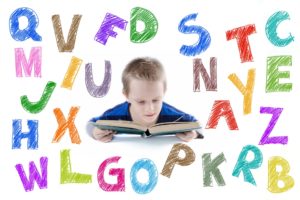Hey fellow educators! There is a lot more to teaching reading than can be put down in a blog post. People spend their entire careers teaching reading and still learn new things every day, so I want to make clear that this is not the end all, be all on how to teach reading to students. I’ve been teaching for over two decades. Some of that time was spent teaching reading to elementary students. I was away from teaching reading for a bit, but I’ve been brought back into it due to some creative shuffling of schedules this year by the administration. Alas, I found myself teaching a group of students focusing on fluency and comprehension. I also found myself sitting in meetings with Title teachers listening to a bunch of strategies for various readers. I honestly felt pretty overwhelmed for a couple of days.
I’ve also had several student teachers in my time. One thing that never changes is that these new teachers feel like they’ve never actually been taught “how” to teach reading. Since I was getting myself set for taking on a new reading challenge, I decided I’d put something together for my student teacher. Once I started doing that, I thought I’d post it here. This is primarily a nuts and bolts-type post. I think of it as what you might get if you boiled down a college “teaching reading” textbook to a couple of thousand words and filtered it through someone who has been teaching for a while. (It actually ended up being closer to 4,000, but who’s counting?) I know it isn’t perfect, but I hope you’ll find it helpful. I may work on something similar for the other subjects I’ve taught as well. If you like it or would like to share some tips for teaching reading, please leave a comment!
Vocabulary for Teaching Reading
I thought I’d start out with a list of “teacher words” that reading teachers need to know and understand. Sometimes even teacher-to-teacher discussions are full of expressions and jargon that you might not remember. I also realize that there might be some non-teachers here who just want to help their child learn how to read. Each of these words could probably hold up to a blog post of its own, but we’ll start off with a basic understanding.
- Fluency: Fluency means being able to read a piece of text with accuracy, smoothness, and expression. Fluent readers read quickly and easily, allowing them to concentrate on understanding the text rather than figuring out how to decode the words.
- Comprehension: Comprehension is the process of understanding and interpreting the meaning of a text. Good comprehension skills involve actively engaging with the text, making connections, and thinking critically about what you’re reading.
- Vocabulary: Vocabulary is the words that a person knows and understands. Building a strong vocabulary is important for reading comprehension, since understanding the meanings of words is key to understanding the overall meaning of a text.
- Phonics: Phonics is a method of teaching reading that focuses on the relationship between letters and sounds. By learning the sounds that letters and letter combinations represent, students can decode unfamiliar words and improve their reading fluency.
- Decoding: Decoding is the process of translating written words into sounds or meanings. When students can decode unfamiliar words, they are better able to understand the text they’re reading.
- Sight Words: Sight words are common words that are frequently encountered in text and that aren’t easily sounded out using phonics. Examples of sight words include “the,” “and,” and “was.”
- Syntax: Syntax is the way words are arranged and put together to form sentences. Teaching students about syntax can help them understand the structure of language and improve their reading comprehension.
- Text Structure: Text structure is the way that information is organized within a text. Different types of text structures include chronological, cause and effect, problem and solution, and compare and contrast. Understanding text structure can help students better understand and remember the information in a text.
- Genre: Genre refers to the type or category of a text, such as fiction, nonfiction, poetry, or drama. Teaching students about different genres can help them understand the characteristics and conventions of each type of text.
- Inferencing: Inferencing is the process of making educated guesses about information that isn’t explicitly stated in a text. It involves using clues from the text, as well as prior knowledge and experience, to draw conclusions and make predictions.
- Text Complexity: Text complexity is the level of difficulty of a text, as determined by factors such as vocabulary, syntax, and structure. When selecting texts for students to read, it’s important to consider the level of text complexity that is appropriate for their reading skills and abilities.
- Text-Based Questions: Text-based questions are questions that are directly related to the content of a text and that require students to use evidence from the text to support their answers. Asking text-based questions can help students develop their critical thinking skills and improve their comprehension of the text.
- Text Evidence: Text evidence is the specific information from a text that is used to support an answer or argument. Teaching students to use text evidence can help them develop their reading comprehension skills and become more proficient at making inferences and drawing conclusions from what they read.
- Reading Workshop: A reading workshop is a teaching approach that emphasizes student choice, independent reading, and small group instruction. Reading workshops typically involve students selecting their own texts to read, setting personal reading goals, and participating in various reading-related activities such as group discussions and writing about what they have read.
- Differentiated Instruction: Differentiated instruction is a teaching approach that involves tailoring instruction to meet the individual needs and abilities of each student. When teaching reading, this might involve using a variety of texts at different levels of complexity, providing different types of support and resources, and using a variety of teaching strategies to meet the diverse needs of students.
- Guided Reading: Guided reading is a teaching approach that involves working with small groups of students who are at similar reading levels to provide targeted instruction and support. During a guided reading lesson, the teacher may provide support with vocabulary, comprehension, and other reading skills through a variety of activities such as shared reading, word work, and discussion.
- Word Work: Word work is a term used to describe activities that focus on building students’ knowledge of words and word patterns. This might include activities such as phonics instruction, vocabulary development, and spelling practice.
- Close Reading: Close reading is a method of reading and analyzing a text in detail, with the goal of gaining a deep understanding of its meaning and structure. When teaching close reading, the teacher might model the process, provide supports and scaffolds, and encourage students to ask questions and make connections as they read.
- Shared Reading: Shared reading is a teaching approach in which the teacher and students read a text together, with the teacher providing support and scaffolds as needed. Shared reading is often used to introduce new texts or concepts and to build reading skills such as fluency, comprehension, and vocabulary.
How to Teach Reading to a Diverse Group of Students
Reading is a fundamental skill that is essential for success in school and beyond. It is also a complex process that requires a range of strategies and approaches to effectively teach to a diverse group of students. In this post, we will explore a variety of approaches and techniques for teaching reading to beginners, assessing reading levels and progress, improving fluency, teaching comprehension strategies, and differentiating instruction. We will also delve into the unique considerations and challenges of teaching reading to English language learners, struggling readers, students with dyslexia or other learning disabilities, and students with special needs. Finally, we will discuss the importance of using reading assessments to inform instruction and create a comprehensive reading program for your classroom or school.
The Most Effective Method for Teaching Reading to Beginners
If you’re teaching reading to beginners, it’s important to have a solid foundation in phonemic awareness and phonics. Phonemic awareness is the understanding that words are made up of individual sounds, or phonemes. This skill is super important for helping students learn to decode words and read accurately. Phonics is the systematic study of the relationship between letters and sounds. When teaching phonics, it’s best to start with the most basic sounds and work up to the more complicated ones.
 There are lots of activities and exercises that can help students develop their phonemic awareness and phonics skills. Here are a few:
There are lots of activities and exercises that can help students develop their phonemic awareness and phonics skills. Here are a few:
- Rhyming games: Students can listen to and generate rhymes, which helps them notice and manipulate the sounds in words.
- Phoneme segmentation: Students can be asked to break words into individual sounds, or phonemes. For example, they might be asked to say the word “cat” as “c-a-t.”
- Phoneme blending: Students can be asked to blend individual sounds together to form a word. For example, they might be asked to blend the sounds “c-a-t” to form the word “cat.”
Sight words are another important aspect of beginning reading instruction. Sight words are common words that are often difficult to sound out using phonics rules. Examples of sight words include “the,” “is,” and “and.” It is important to regularly review and practice sight words with students to help them build their reading fluency and confidence.
Assessing Reading Levels and Progress
Assessing your students’ reading levels and progress is a big part of teaching reading. There are lots of different reading assessments you can use to figure out a student’s reading level and track their progress over time. Some common types of reading assessments include:
- Running records: Running records are a way to assess a student’s reading level and accuracy by having them read a passage and noting any mistakes or challenges they have.
- Standardized tests: Standardized tests, like the DIBELS or Fountas & Pinnell Benchmark Assessment System, give you a way to measure student progress and figure out their reading level.
- Informal assessments: Informal assessments, such as observation, anecdotal records, and checklists, give you a way to regularly check in on student progress and identify their strengths and weaknesses.
It’s important to regularly assess your students’ reading levels and progress so you can guide your instruction and set goals for student growth.
Improving Fluency
Being able to read smoothly, accurately, and expressively is called fluency. Fluent readers can focus on understanding the meaning of the text instead of figuring out how to decode words. There are a bunch of strategies you can use to improve fluency, including:
- Repeated readings: Have students practice reading a passage multiple times to improve their fluency and accuracy.
- Choral reading: Have students read a passage aloud in unison with you or a recording to improve their fluency and expression.
- Partner reading: Have students practice reading with a partner, taking turns reading sections of a text aloud. This can help improve fluency and give struggling readers some support.
It’s also important to assess and track fluency progress. You can do this through running records or timed readings, where students read a passage for a set amount of time and you record how many words they read correctly.
Teaching Reading Comprehension Strategies
Teaching your students how to think about and understand what they’re reading is a big part of teaching reading. There are a bunch of strategies you can use to improve comprehension, including:
- Making predictions: Encourage your students to make predictions about what will happen next in a text based on their prior knowledge and clues from the text.
- Asking questions: Teach your students to ask questions about the text to help them better understand and engage with the content.
- Summarizing: Teach your students to summarize the main ideas and key details of a text to help them better understand and remember the content.
There are lots of activities and exercises you can use to practice comprehension strategies. For example, you can ask your students to create a graphic organizer to represent the main ideas and supporting details of a text, or you can have them participate in a discussion about the text to practice asking and answering questions.
Vocabulary Development
Vocabulary is super important for reading comprehension. Students need a lot of vocabulary words to understand and make sense of texts. There are a bunch of strategies you can use to teach new vocabulary words, including:
- Using context clues: Teach your students to use the words and sentences around a new vocabulary word to help them understand its meaning.
- Word associations: Have your students create associations with new vocabulary words to better remember and understand them. For example, they might create a mental image or use a word association to help them remember the meaning of a new word.
There are also lots of activities and exercises you can use to practice vocabulary development. These might include making flashcards with the vocabulary word and its definition, creating a word wall with new vocabulary words, or using games and activities to practice using the new words in context.
Differentiating Instruction
Differentiating instruction means tailoring your teaching to meet the needs and learning styles of individual students. This is especially important when teaching reading, since students might have different levels of readiness, learning styles, and interests. Some strategies for differentiating reading instruction include:
- Providing different text levels: Give your students texts at their appropriate reading level to challenge and engage them.
- Using alternative assessment methods: Instead of traditional written tests, you can assess your students through projects, presentations, or other alternative methods that better reflect their strengths and learning styles.
- Providing choice: Letting your students choose their own reading materials can help increase their engagement and motivation.
- *Note* I find the biggest challenge with differentiating reading is managing time, students and assessment at different levels during a class period. If anyone has a solution for that, please leave it for the rest of us in the comments!
Teaching Reading to English Language Learners
So if you’re trying to teach reading to English language learners, you should know that it can be a bit different than teaching reading to native English speakers. These students might have a harder time with phonics and learning new vocabulary words because English might sound and be written differently than their first language. It’s important to give these students extra support and make it easier for them to understand as they’re learning to read in a new language.
Here are a few strategies that can help:
- Using picture dictionaries: These can be really helpful for ELLs because they provide a visual representation of new vocabulary words.
- Providing extra support for phonics and vocabulary development: Sometimes, ELLs might need more practice and support with learning the sounds and symbols of English. You might want to try doing extra phonics instruction or using bilingual texts to make it easier for them.
- Incorporating the students’ home language: If you can, try using the students’ home language to help them understand and learn English. This can be especially helpful for building vocabulary and comprehension skills.
*Note* My note here is a special little blessing for all of the teachers who work with English language learners, as well as their students. Your patience must be extraordinary. If I was dropped into a foreign country and didn’t know the language, I’d be so thankful for anyone willing to help me.
Engaging and Motivating Struggling Readers
 If you’ve got some students who are struggling with reading, it’s important to give them extra support and encouragement to keep them motivated and engaged. Here are a few strategies that can help:
If you’ve got some students who are struggling with reading, it’s important to give them extra support and encouragement to keep them motivated and engaged. Here are a few strategies that can help:
- Providing extra help: Sometimes, struggling readers just need a bit more one-on-one or small group instruction to catch up with their peers.
- Using books at the right reading level: It’s important to give your students books that are at an appropriate reading level for them. This way, they’ll be challenged without feeling overwhelmed.
- Encouraging a love of reading: One of the best ways to keep struggling readers motivated is to help them find books that they’re interested in and enjoy reading. This can go a long way in keeping them engaged and excited about reading.
Reading Across the Curriculum
If you want to make learning more meaningful and engaging for your students, try incorporating reading into your subject-specific lessons. For example, you could use reading passages and texts related to science or social studies to help your students better understand and connect with the content. Here are a few other strategies you might try:
- Asking students to read and discuss texts as part of a small group or whole class activity: This can be a great way for students to practice their comprehension skills and build their vocabulary.
- Incorporating reading into projects and activities: You could ask your students to do some research and read about a topic in order to complete a project or activity related to the subject matter. This can be a fun and engaging way to help them learn and apply what they’ve read.
Teaching Reading to Children with Dyslexia or Other Learning Disabilities
If you’re teaching reading to students with dyslexia or other learning disabilities, you might need to approach it differently than you would with typically developing students. It’s important to work closely with specialists, like speech therapists or occupational therapists, to make sure you’re giving these students the support they need. Here are a few strategies you might try:
- Using multisensory techniques: Techniques that engage multiple senses, like using manipulatives or visual aids, can be really helpful for students with dyslexia or other learning disabilities.
- Providing accommodations: Sometimes, students with learning disabilities need a little extra help to keep up with their peers. Accommodations like extra time on assignments or text-to-speech software can really make a difference.
Using Children’s Literature to Teach Reading
Children’s literature can be a really valuable tool for teaching reading. These books often have engaging storylines, rich vocabulary, and age-appropriate themes that can keep students motivated and engaged in reading. Here are a few tips for using children’s literature in your reading instruction:
- Selecting age-appropriate books: It’s important to choose books that are appropriate for the age and reading level of your students.
- Incorporating a variety of genres: Mixing up the genres of books you use can help keep students interested and engaged.
- Using literature to teach reading skills: Children’s books can be great for teaching a variety of reading skills, like phonemic awareness, phonics, fluency, comprehension, and vocabulary development. So, try to use children’s literature to teach these skills to your students.
Teaching Reading to Young Children
If you’re teaching reading to young children, like pre-kindergarten and kindergarten students, you’ll need to approach it a bit differently than you would with older students. It’s really important to build a strong foundation in reading for these kids by focusing on phonemic awareness and phonics. Here are a few strategies you might try:
- Using rhyming games: Rhyming games can be a lot of fun for young children, and they can also help them develop phonemic awareness and understand the sounds in words.
- Emphasizing phonemic awareness: Teaching young kids about the individual sounds, or phonemes, in words can help them learn to decode words and read more accurately.
- Using interactive read-alouds: Reading aloud to young children and engaging them in the story through questioning and discussion can be a great way to build their vocabulary and comprehension skills. It’s also a great opportunity for kids to hear how words are pronounced and used in context.
Teaching Reading to Older Students
When you’re teaching reading to older students, like middle and high school students, you’ll need to approach it a bit differently than you would with younger students. It’s important to engage and support these students in reading by using high-interest texts and incorporating student choice. Here are a few strategies you might try:
- Using high-interest texts: Selecting texts that are of interest to older students can be a great way to keep them motivated and engaged in reading.
- Incorporating student choice: Allowing older students to choose their own reading materials can be a great way to increase their engagement and motivation.
- Using literature circles: Literature circles, where students read and discuss a text in a small group setting, can be a really effective way to engage older students in reading and build their comprehension skills. It’s also a great way for students to share their thoughts and ideas about the text with their peers.
Teaching Reading to Multilingual Students
If you’re teaching reading to multilingual students, or students who speak more than one language, you’ll need to approach it a bit differently than you would with monolingual students. It’s really important to support these students in learning to read in a new language by incorporating their home languages and using bilingual texts. Here are a few strategies you might try:
- Incorporating the students’ home language: Using the students’ home language can be a great way to provide a bridge to learning English and can be helpful in building vocabulary and comprehension skills.
- Using bilingual texts: Bilingual texts, or texts that are written in both the students’ home language and English, can be really supportive and helpful for multilingual students as they learn to read in a new language.
- Providing extra support for phonics and vocabulary development: Sometimes, multilingual students might need a bit more practice and support with learning the sounds and symbols of English. It can be helpful to give them extra instruction or use bilingual texts to make it easier for them.
Teaching Reading to Students with Special Needs
Teachers who are teaching reading to students with special needs, need to approach it a bit differently than they would with typically developing students. It’s really important to work closely with specialists, like speech therapists or occupational therapists, to make sure you’re giving these students the support they need. Here are a few strategies you might try:
- Using multisensory techniques: Techniques that engage multiple senses, like using manipulatives or visual aids, can be really helpful for students with special needs.
- Providing accommodations: Sometimes, students with special needs need a little extra help to keep up with their peers. Accommodations like extra time on assignments or text-to-speech software can really make a difference.
- Differentiating instruction: Differentiating instruction, or tailoring instruction to meet the needs and learning styles of individual students, is especially important when teaching reading to students with special needs. This can help ensure that all your students are getting the support and instruction they need to succeed.
Creating and Implementing a Comprehensive Reading Program
 So to summarize: If you want to create and implement a comprehensive reading program, here are a few things you’ll want to keep in mind:
So to summarize: If you want to create and implement a comprehensive reading program, here are a few things you’ll want to keep in mind:
- Differentiate your instruction: It’s important to tailor your instruction to meet the needs and learning styles of your individual students. This is especially important when teaching reading to students with special needs, multilingual students, or struggling readers.
- Use a variety of strategies: There are lots of different strategies you can use to support your students in learning to read. Some examples include using picture dictionaries, providing extra support for phonics and vocabulary development, incorporating the students’ home language, using high-interest texts, incorporating student choice, and using literature circles.
- Work with specialists: If you’re teaching reading to students with special needs, dyslexia, or other learning disabilities, it’s important to work closely with specialists like speech therapists or occupational therapists to make sure you’re giving your students the support they need.
- Use children’s literature: Children’s literature can be a really valuable tool for teaching reading. These books often have engaging storylines, rich vocabulary, and age-appropriate themes that can keep students motivated and engaged in reading.
- Incorporate reading into subject-specific lessons: If you want to make learning more meaningful and engaging for your students, try incorporating reading into your subject-specific lessons. For example, you could use reading passages and texts related to science or social studies to help your students better understand and connect with the content.
Final thoughts
Reading is such an important skill, and it’s essential for success in school and beyond. It’s also a complex process that requires a variety of skills and strategies to be successful. If you want to teach reading effectively, you’ll need to focus on building a strong foundation in phonemic awareness, phonics, and fluency, as well as teaching comprehension strategies and vocabulary development. It’s also really important to make sure your students are engaged and motivated. By using a variety of approaches and strategies, you can support your students in becoming confident and competent readers. Remember, every student is different, so it’s important to differentiate your instruction and meet the needs of each individual student. With the right approach and support, your students can become successful readers.
If you found this helpful, please share and comment!
THANK YOU!!! 😎
Read more about Instructional Strategies!








